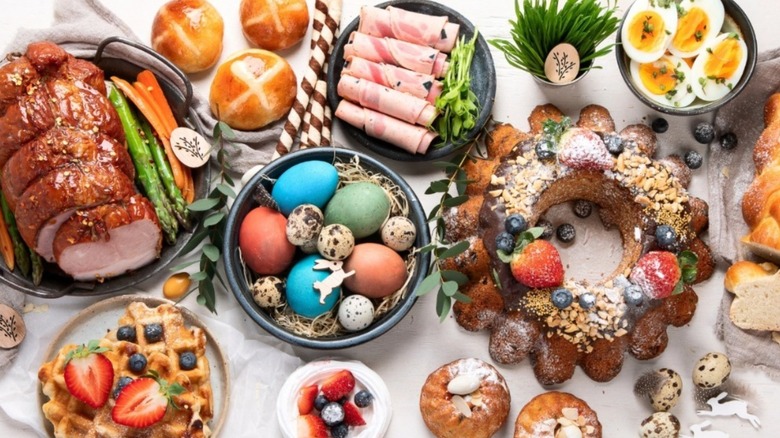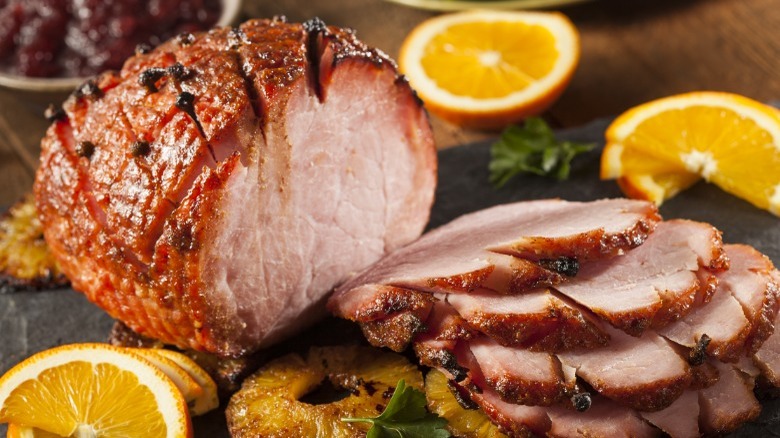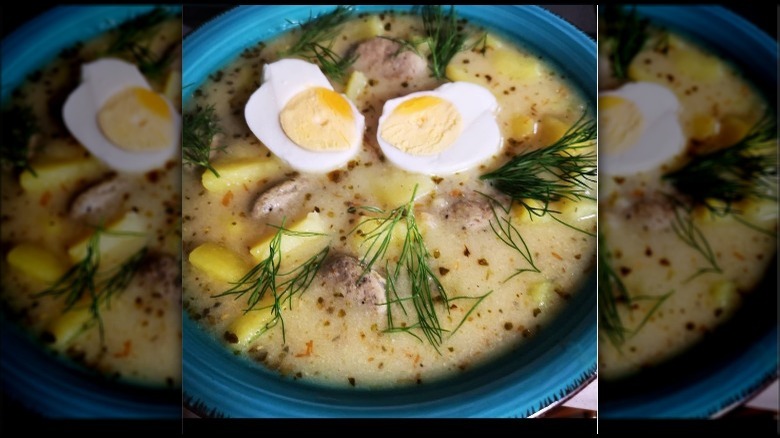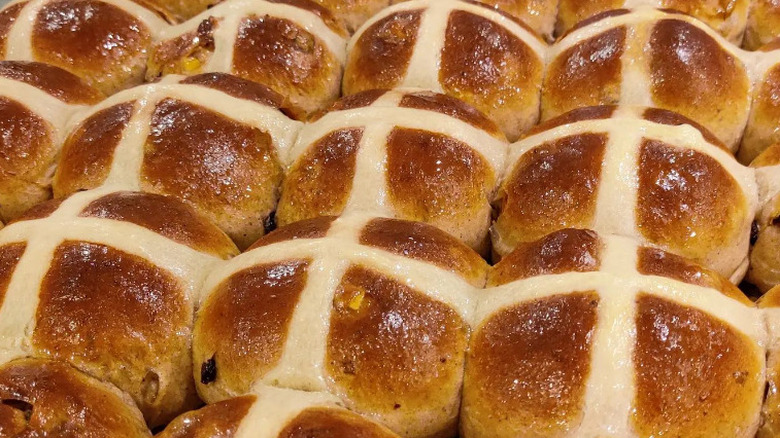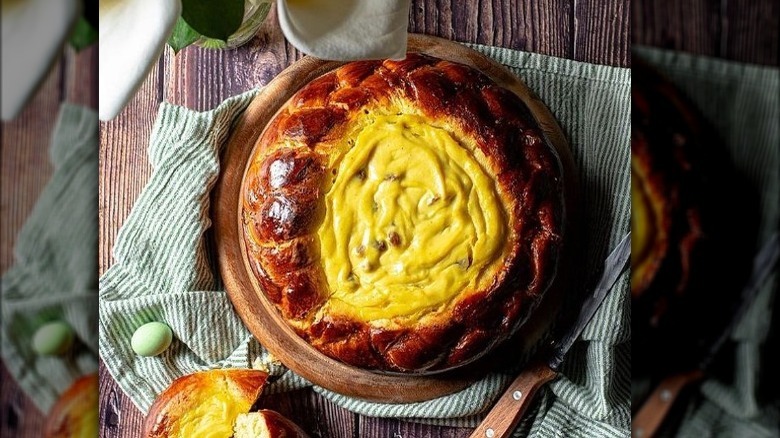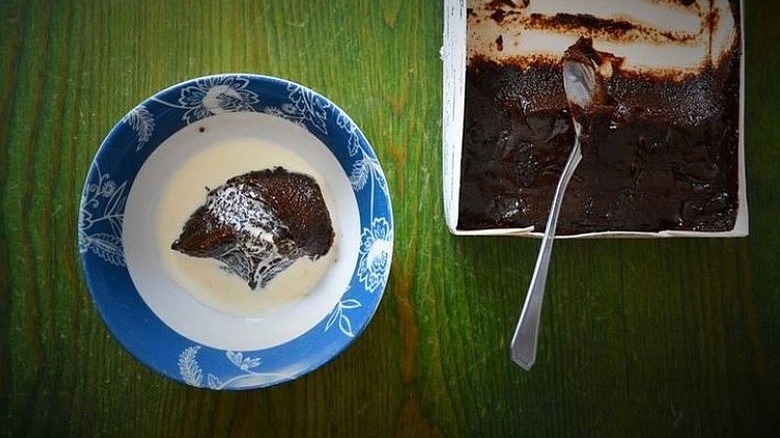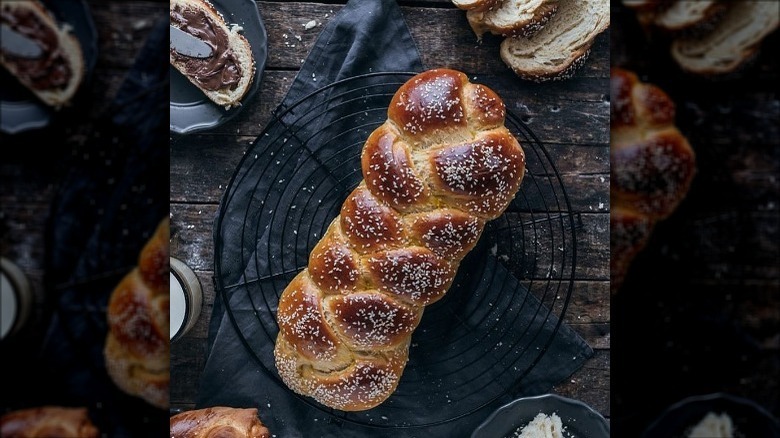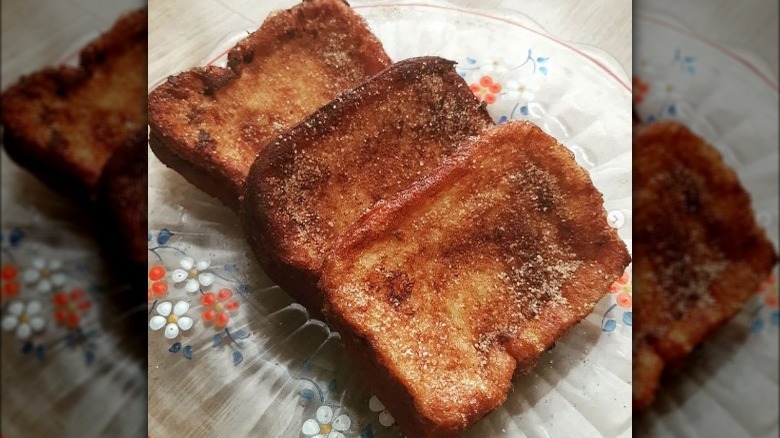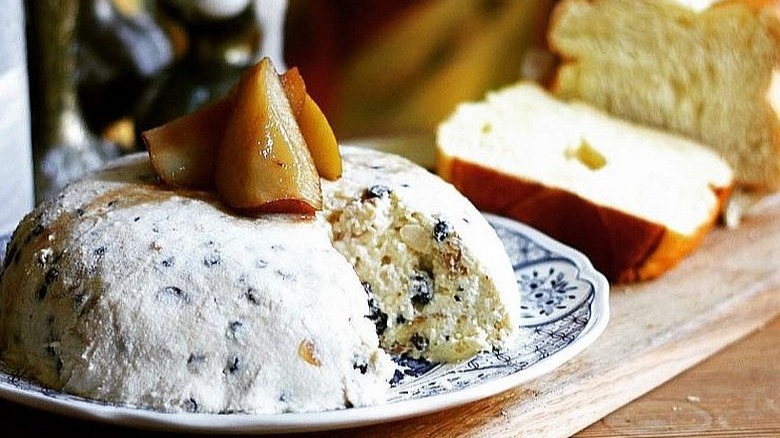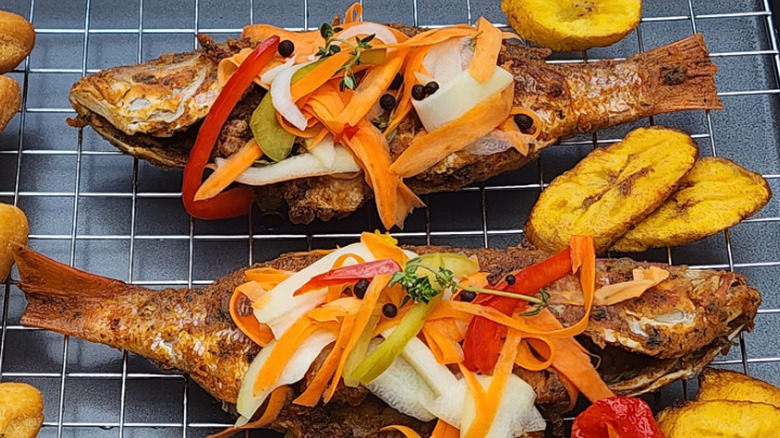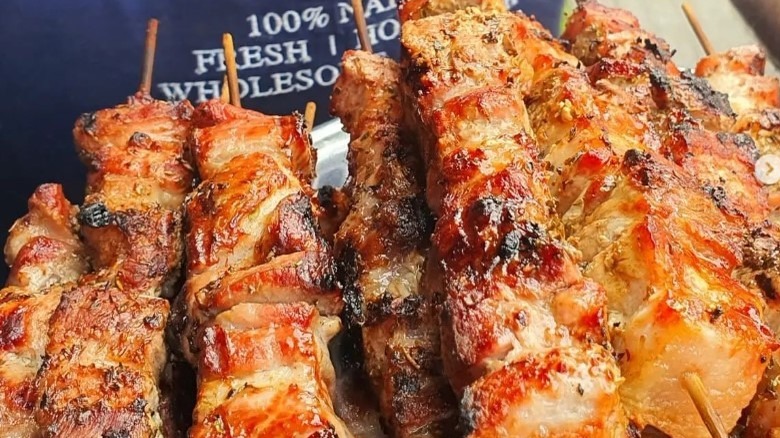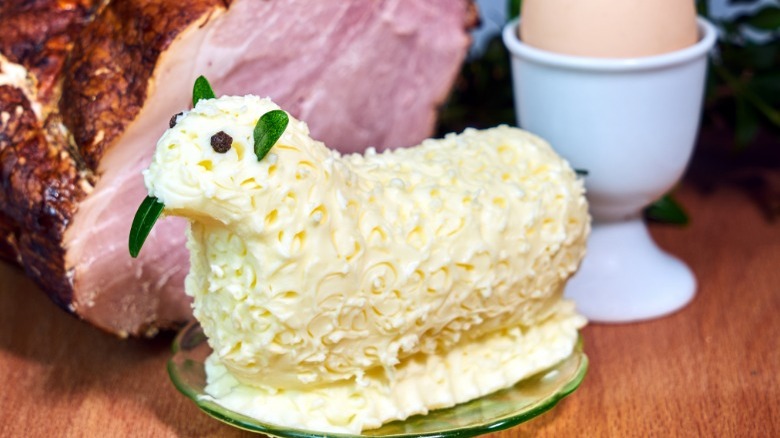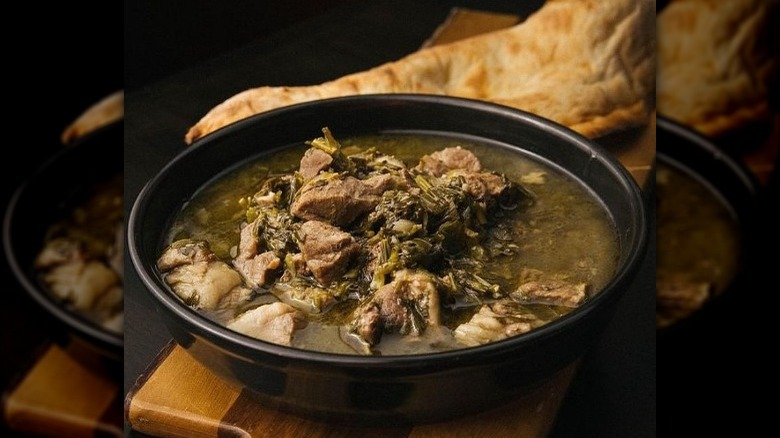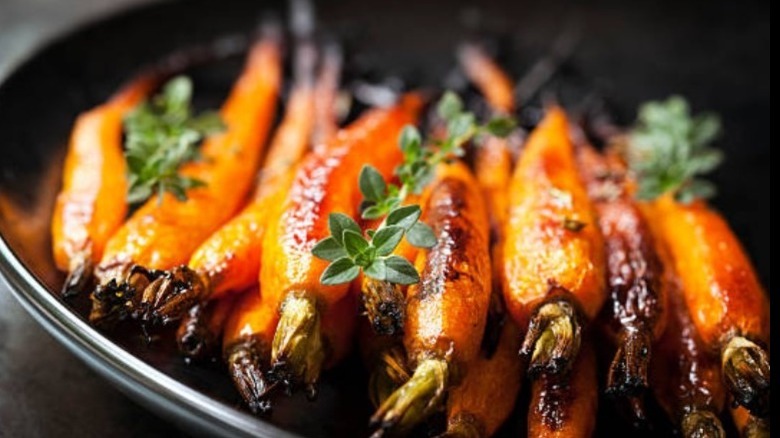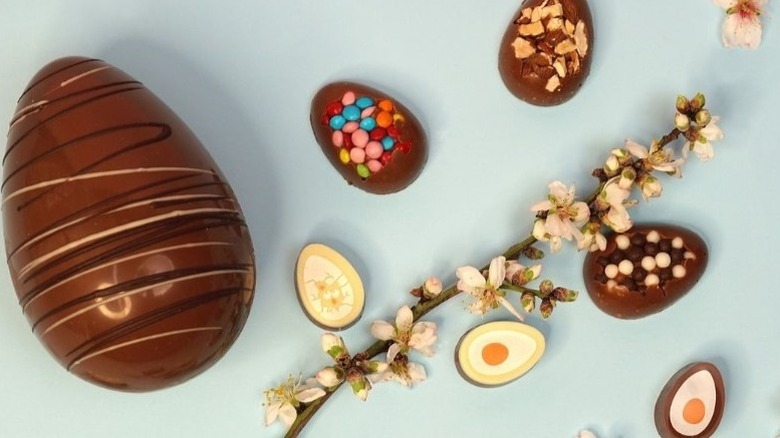14 Easter Food Traditions From Around The World
We may receive a commission on purchases made from links.
Easter is a time of celebration, and a big part of this holiday is the delicious food that is cooked and served at gatherings. Easter is celebrated worldwide, and while we might eat roast ham and chocolate eggs in the U.S., many countries have their own traditional foods and ways of celebrating. Some countries — like Greece — even celebrate Easter on a different day.
Different cultures have their own takes on Easter celebrations, often steeped in the country's heritage and religion. From the UK's hot cross buns to Eastern Europe's butter lamb, Romania's cheesecake bread to Georgia's hearty lamb stew, each dish has its own story to tell.
It's fascinating to see where these traditions have come from and what differences and similarities they have. Whatever way you choose to celebrate Easter, we've rounded up some Easter food traditions from around the world to give you a little insight into how others mark this special holiday.
1. USA: Roast ham
Roast ham is the traditional U.S. Easter dish, often glazed with honey, maple syrup, or brown sugar, and sometimes studded with cloves. Many people choose to serve their ham with grilled pineapple slices for a delicious sweet and savory take on this Easter tradition.
But why do we eat ham on Easter? Though lamb was historically the traditional meat of choice for Easter celebrations, the switch to ham has nothing to do with religion — we eat it because it's in season and more affordable than lamb. Many countries in the world do still enjoy roast lamb for Easter dinner, though.
Ham became more popular when farmers realized it could be cured to preserve it through the long winter months, ensuring it was ready to eat by the time Easter rolled around in the spring. Not everyone in the U.S. tucks into a roast ham on Easter Sunday, though, with many families opting for roast beef or chicken instead.
2. Poland: Zurek
Zurek is a sour rye soup traditionally served in Poland at Easter time. Prepared with spicy white Polish sausage, smoked meat, potatoes, spices, sour rye starter, carrots, and basil, it's traditionally served with a boiled egg. You'll often find it served in a hollowed out edible bread roll.
The name "Zurek" comes from the old German word "Sur" meaning "sour" due to the addition of the sour rye starter, giving the soup its trademark sour flavor. There are several origin stories for this soup, but the most interesting one is that of the Mean Innkeeper.
The story goes that a tight-fisted innkeeper in a Polish village regularly served disgusting food made with poor ingredients at his tavern. As word spread, people began avoiding the village entirely. Locals decided to teach him a lesson and sent a greedy local man, dressed in fine clothes, with a bag of gold, to eat at the tavern.
The man made a bet with the innkeeper that if he made the worst soup he could think of and he was able to eat it, the innkeeper could keep the gold. Of course, the innkeeper jumped at this opportunity, preparing soup with rotten vegetables, water, rye, old sausage, and anything else he could find.
Surprisingly, the visitor finished the bowl of soup and asked for another, with locals arriving to try the soup, drawn to the tavern by the smell. The "mean innkeeper" gave away the soup's recipe, and his tavern, and never returned to the village.
3. UK: Hot cross buns
Traditional hot cross buns were baked with juicy raisins and eaten on Good Friday in the UK. You'll now find various flavors, including those studded with chocolate or salted caramel or packed with berries, for sale all year around.
Hot cross buns are so-called due to the cross marked on the top to represent the crucifixion of Christ. Hanging hot cross buns in your kitchen was also said to ward off evil spirits and prevent kitchen fires.
It's said that hot cross buns date back to the 12th century, when a monk baked them on Good Friday as a celebratory feast for the upcoming Easter weekend. They were first mentioned in writing in a 16th century text, which reads: "Good Friday comes this month, the old woman runs, with one or two a penny hot cross buns."
Others claim the buns have pagan roots. In Ancient Egypt, small bread rolls were marked with crosses in celebration of the Gods, with similar breads seen in Ancient Greek and Rome.
We may never truly know the origins of the hot cross bun, but the fact remains that they're a delicious treat, particularly split, toasted, and slathered with a generous helping of salted butter. You could even give these buns as a gift to friends, as this is said to strengthen your friendship.
4. Romania: Pasca
Pasca is a traditional sweet Romanian Easter bread that's very similar to Italian Pannetone. In Romania, the bread is filled with a sweetened cheesecake mix made with branza de vaci (cow's cheese)with rum and raisins, but blended cottage cheese can be used as a substitute. Bread of the same name — but without the filling — is also eaten in Ukraine over Easter.
Pasca was traditionally the first food consumed for Easter breakfast, marking the end of 40 days of Lent. Today, it is baked and enjoyed throughout Romanian Easter celebrations.
The golden color of Pasca represents the sun, the bringer of life, and there are various ancient traditions and superstitions associated with the baking of the bread. It's said that if the bread breaks when you take it out of the oven, or if it doesn't rise, the household will see a death that year. A less morbid belief states that nobody should taste the bread before it's blessed at the Easter Sunday church service, even those responsible for preparing it.
5. Finland: Mämmi
Mämmi is a traditional Finnish dessert eaten at Easter time in Southern Finland. Made with rye malt, rye flour, sugar, orange zest, and raisins, it has a doughy, dark rye flavor that's an acquired taste. It's a polarizing dish, with people either loving it or being unable to stand it. Some recipes also use molasses.
Mämmi doesn't take long to prepare and bake but does need to chill for three to four days in the fridge. It's for this reason that many people in Finland nowadays buy their Mämmi already prepared. Whether made from scratch or bought at the local store, Mämmi is traditionally served with cream and sugar or milk.
This dish has a long history and is thought to have its roots in the 13th century. A similar-sounding dark sweet Easter porridge made an appearance in texts dating back to 1700, so Finnish people may have been enjoying this Easter treat for quite some time.
6. Greece: Tsoureki
Tsoureki is a sweet bread similar to brioche that's traditionally prepared on Holy Thursday before Orthodox Easter. It's delicious served for breakfast and dunked in coffee, and also makes excellent french toast.
In Greece, various flavors of Tsoureki are available to buy in shops throughout the year. However, the authentic Easter version is made with butter, eggs, milk, flour, sugar, yeast, and salt. There are two special ingredients added to impart Tsoureki's unique flavor: mahlepi, a spice made from ground cherry seeds, that adds almond-y flavor, and mastic (pine resin gum) which gives the bread bitter, refreshing pine-y notes.
Tsoureki is thought to date back to Byzantine times, when similar breads were baked for Easter. It's plaited with three strands, thought to chase away evil spirits, and is said to represent Christ's resurrection. At Easter, a dyed red egg is often served on top of the bread to symbolize the blood of Jesus.
7. Spain: Torrijas
Torrijas is a Spanish sweet treat eaten across the country during Holy Week, and it's incredibly similar to french toast. Made as way to use up stale bread, the slices are soaked overnight in milk (or wine, honey, or syrup), then dipped in egg, fried, and topped with cinnamon sugar.
One of Europe's oldest desserts, Torrijas became a popular food in the Middle Ages during Lent. The delicious treat is eaten with wine and represents the body and blood of Christ.
While torrijas are traditionally served during Easter time, you can now often find them on regular menus across Spain, so you don't have to wait for Lent to enjoy them. In fact, because they are such an affordable and accessible dish, torrijas are found on the menú del día, a traditional worker's menu that was once required to be offered at all restaurants in Spain.
8. Russia: Pashka
Pashka, from the Russian word for "Easter," is a cheesecake-like dessert served on Easter Sunday in Russia. Though it's traditionally made with tvorog (cheese curds), blended with butter, sugar, eggs, nuts, and dried fruit, a mix of cottage cheese and cream cheese can be substituted for the curds. Some recipes add candied fruit, cinnamon, nutmeg, or vanilla to the mix.
Pashka is similar to the Romanian dish Pasca, but without the sweet bread. However, this dessert is usually spread on Kulich, a sweet panettone-like bread that's also found on Russian dinner tables over Easter.
This dessert is usually made in a pyramid-shaped mold to represent the tomb of Christ, with the Russian letters X and B imprinted on the inside of the mold, meaning "Christ is risen!" Traditionally, Pashka is taken to church along with Kulich in an Easter basket, to be blessed before the family sits down to enjoy it.
9. Jamaica: Eskovitch
Every Easter, Jamaicans whip up a traditional fish dish known as Eskovitch. The name of the dish is similar to a Spanish dish, Escabeche, but the Jamaican version adds lime juice, heat from fiery Scotch Bonnet chili, and fried bell peppers, carrots, and onions.
The fish is the star of the dish and is marinated in a spicy sauce then fried until crispy and topped with vegetables. Red snapper is the fish most commonly used in Eskovitch, but almost any fish works as an alternative.
Eskovitch is traditionally prepared on Holy Thursday, because it was believed to be bad luck to light a fire before noon on Good Friday. Preparing the dish in advance limits the amount of time spent in the kitchen on the holy day.
This delicious, spicy fried fish dish is usually served with bammy, a traditional Jamaican flat bread made with manioc (cassava) or rice. It's definitely not a dish for those who don't like spicy food, however, as the addition of Scotch Bonnet chilis fires up the heat!
10. Cyprus: Souvla
Souvla is the main dish typically served on Greek Easter Sunday, a full day of feasting for families. This marinated meat skewer is traditionally made with lamb, though pork or chicken can also be used. The meat is simply seasoned with salt, pepper, and oregano.
It's easy to confuse souvla with souvlaki but the two are actually very different. Where souvla is a chunky slow-cooked meat skewer typically served as a main course at family gatherings, Souvlaki is a popular street food designed to be eaten on the go, made with smaller pieces of grilled meat served in a pitta bread with onion, parsley, tomato, and sauce.
Traditionally, souvla is cooked slowly over a spit or on a hot grill, with the men of the household monitoring the cooking as the women prepare side dishes. These dishes often include lemon potatoes and a Horiatiki salad, which is made with feta cheese, cucumber, tomatoes, olives, and onion.
11. Eastern Europe: Butter lamb
A butter lamb may sound like a tasty, meaty dish, but we're actually talking about butter sculpted into the shape of a lamb, symbolizing the sacrifice of Jesus Christ (the Lamb of God) and the beginning of spring. Often found on Easter tables across Poland, Russia, and Slovenia, the tradition of the butter lamb later spread to the U.S. Midwest.
It's thought that the butter lamb originated as a way to use up butter before Lent, a time when people usually gave up dairy. The lamb usually has peppercorns for eyes, and often has a red ribbon around its neck to represent the blood of Christ.
Butter lambs quickly became popular in areas of the U.S. with a large Polish population, such as Michigan, Milwaukee, New York, and Illinois. In the 1960s, Malczewski Butter Lambs appeared on shelves at Broadway Market in Buffalo, where you can still buy them today. Created by Dorothy Malczeski, these cute little lambs feature a red flag on their backs saying "Alleluia" and the traditional red ribbon around their necks.
Of course, you could always make your own butter lamb for Easter, and luckily you don't need to be an expert sculptor to do so. You'll find butter lamb molds available to purchase on various websites, including Amazon.
12. Georgia: Chakapuli
Every Easter, Georgians sit down to a hearty, warming bowl of Chakapuli, a lamb stew made with tarragon, green peppers, scallions, white wine, and chives. There's one key ingredient that gives this stew its distinctive sweet-sour flavor: Tkemali, or green plums.
These plums are in season during the spring, so preparing Chakapuli marks the approaching warmer summer months. It can often be quite chilly in parts of Georgia at Easter time, so this cozy stew is served with home-made bread to mop up the sauce.
Chakapuli takes its name from the traditional clay pot it is cooked in, and it's been around for a long time. Its origins date back to the 17th century, and it's thought to have its toots in the Kakheti region in the east of the country.
If you don't fancy lamb, you can make Chakapuli with chicken or substitute mushrooms for a vegetarian version. If you can't find fresh green plums, specialty stores often stock bottled Tkemali sauce, or you can use lemon juice instead, though the flavor won't be quite the same.
13. USA and UK: Carrots
Is there anything in the world more delicious than roasted and caramelized carrots? Simply roasted with a sugar (or maple syrup) glaze, these vibrantly colored veggies make the perfect delicious side dish for your Easter roast ham or roast lamb.
But why do we eat carrots at Easter? Children traditionally leave out carrots for the Easter Bunny, the mythical creature that rewards them with chocolate eggs on Easter Sunday. Though we don't have a definitive history of the Easter Bunny's origin, it's thought to date back to the arrival of immigrants from Germany to the U.S. in the 18th century. These immigrants brought with them the tale of the "Osterhase" — a hare that laid eggs. Children would create nests for this mysterious rabbit, which later became Easter baskets as the tradition spread across the country.
Carrots don't have to be relegated to side dish status. Why not make them the star dessert of your Easter spread by baking a carrot cake with cream cheese frosting?
14. Worldwide: Chocolate eggs
Around the world, people enjoy giving and receiving chocolate eggs at Easter. But why do we do this?
Eggs are a symbol of fertility, long associated with the months of spring that see nature spring into new life. In the past, eating eggs during Holy Week leading up to Easter was forbidden. This started a tradition where eggs were saved, painted, and gifted to children.
It wasn't until the 19th century that chocolate eggs became popular. The eggs that first showed up in Germany and France during this time were a far cry from our delicious chocolate concoctions of today, though, as they were extremely bitter.
In 1875, Cadbury produced its first chocolate Easter egg made from pure cocoa butter. Though originally made with dark chocolate, its creation spawned the spread of the hollow milk chocolate egg we know and love today.
Eggs have always and will always have a place in Easter celebrations. Children also love to decorate hard-boiled eggs at Easter, and egg rolling has become an annual tradition in many countries, too.
